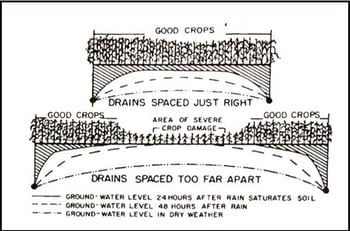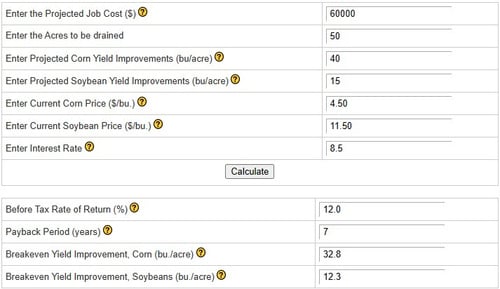Soil Drainage & Drainage Coefficients
By Chris Peacock
Soil Drainage
We assist many of our clients with drainage projects to help improve their farm investment returns. Soil drainage is a key factor in maximizing crop production potential and investment returns in EC Indiana and WC Ohio due to our mineral soils. Soil drainage can often be improved by implementing both surface drainage and subsurface drainage improvements on most local farms.
Subsurface Drainage vs Surface Drainage
Subsurface Drainage focuses on removing the excess water from the soil’s active root zone area in a timely manner. Surface Drainage focuses on minimizing the surface ponding potential resulting from a rain event.
Some of the Benefits of Improved Soil Drainage:
- Ensuring timely planting and field operations.
- Minimizing soil compaction.
- Improving soil porosity.
- Improving soil filtration (subsurface drainage).
- Reducing surface runoff of nutrients (subsurface drainage).
- Increasing Yield Potential. The CCPA (Corrugated Polyethylene Pipe Association) Reports that yields can increase from 15% to 42% for both corn and soybeans by tiling cropland.
- Increasing investment returns potential.
Subsurface Tile Project Considerations:
- Consult with a trusted professional or tile installer that will assist you in achieving your goals.
- Determine the location and capacity of your drainage outlet.
- Utilize a tile design based on the topography of your project area and your drainage outlet.
- Match the tile spacing and tile depth with the soil types. For example, water moves slower in clay soils than in sandy soils. A closer distance between tile lines allows water to drain quicker. Some soils are stratified, which also affects the depth and distance needed for tile placement.
- Determine the Drainage Coefficient that you desire. The larger the Drainage Coefficient, the more expedited your drainage potential becomes.
- Determine dollar amount that you will invest in your tile project but include a 5% contingency for any project surprises or improvements identified once the field operations begin.
- Enjoy your subsurface tile project and future benefits it provides.
Drainage Coefficient
Drainage Coefficient Definition
The University of Minnesota defines the Drainage Coefficient as: “The desired amount of water removed in terms of 24 hours”.
Example: a 3/8” coefficient means that a subsurface tile system can remove 3/8 of an acre inch of water in 24 hours.
Drainage Coefficient Considerations:
This pertains to subsurface tile projects.
Locally, with our mineral soils many farm tile projects utilize a 3/8” drainage coefficient for row crop land. Many County Surveyors utilize a ½” drainage coefficient for legal drains. Many specialty crop farmers utilize a ¾” or greater drainage coefficient due to potential added value of the specialty crop they are producing. With the seemingly larger rain events that we have received the past few years, we have completed several tile projects grain farmers recently that utilize a ¾” drainage coefficient which has shown very impressive results.
Tile Line Spacing

Locally, the desired spacing between tile lines has decreased considerably over the past decade. This is due largely to the clay in our mineral soils and the slow water filtration of these soils and data showing the benefits of more narrow tile spacings. We have installed subsurface tile projects ranging from 50’ on center down to 25’ tile spacings. Many local tile projects today utilize tile spacings of 40’ on center, with a 3/8” coefficient is impressive following a rain event due to how quickly the water filters into the soil.
Profitability of Subsurface Drainage:
 This is a question that I have been asked many times. There are so many variations to subsurface tile projects (soil types, tile spacing, drainage coefficient, etc.) that it is extremely difficult to identify like-kind data. The University of Minnesota Extension assisted PRINSCO Water Management Solutions in developing a handy Profitability Analysis Calculator to consider the investment rate of return for subsurface tile projects. This calculator can be found at: Profitability Analysis Calculator- Prinsco, Inc Prinsco, Inc. https://www.prinsco.com/resources/profitability-analysis-calculator/ Utilizing a 30% yield increase for both corn and soybeans (15% to 42% increase range indicated by CPPA in this calculator) at today’s fall delivery prices estimates a 7-year payback for tile installation projects averaging $1,200 per acre and an 8.5% interest rate (see example chart). We have observed several production increases toward the upper end of the CPPA production increase range, which usually generates more favorable returns.
This is a question that I have been asked many times. There are so many variations to subsurface tile projects (soil types, tile spacing, drainage coefficient, etc.) that it is extremely difficult to identify like-kind data. The University of Minnesota Extension assisted PRINSCO Water Management Solutions in developing a handy Profitability Analysis Calculator to consider the investment rate of return for subsurface tile projects. This calculator can be found at: Profitability Analysis Calculator- Prinsco, Inc Prinsco, Inc. https://www.prinsco.com/resources/profitability-analysis-calculator/ Utilizing a 30% yield increase for both corn and soybeans (15% to 42% increase range indicated by CPPA in this calculator) at today’s fall delivery prices estimates a 7-year payback for tile installation projects averaging $1,200 per acre and an 8.5% interest rate (see example chart). We have observed several production increases toward the upper end of the CPPA production increase range, which usually generates more favorable returns.
